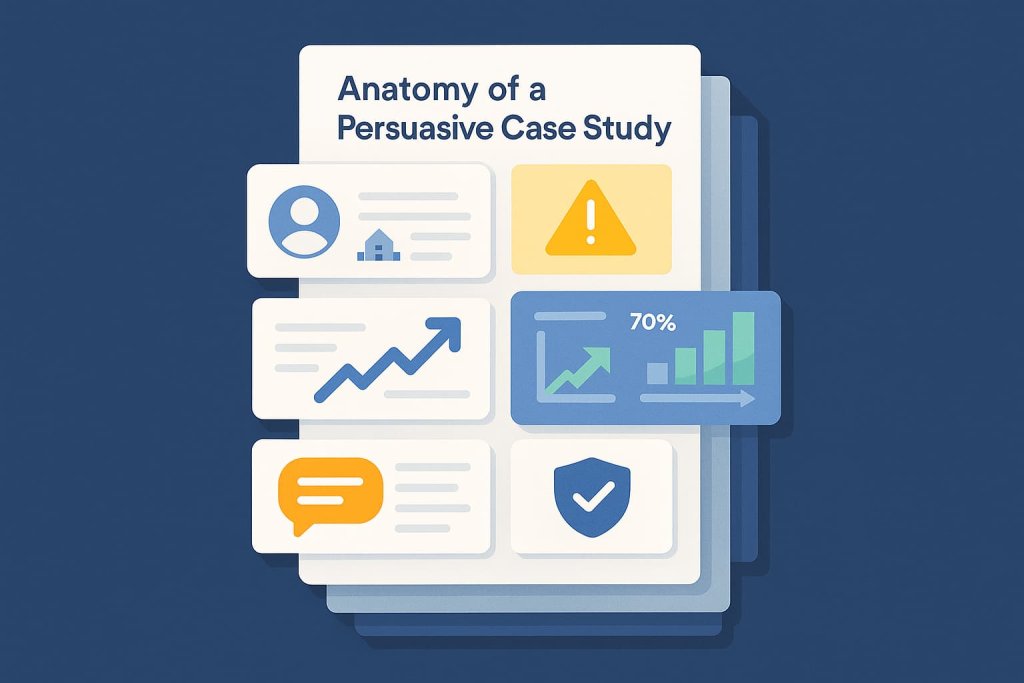The Power of Case Studies in Building Business Credibility
30 September 2025Buyers have become suspicious of big claims. They skim past slogans, discount generic “market-leading” statements, and look for something sturdier. Case studies deliver exactly that – a grounded narrative with real constraints, real decisions, and real outcomes. Done well, they reduce perceived risk, accelerate sales cycles, and give your brand a durable credibility you can’t fake.
This guide explores why case studies work, how to craft them with integrity, and where to deploy them for maximum commercial impact.
Why case studies build credibility
At their best, case studies combine two persuasive forces: story and evidence. The story provides context – a sector, a set of pressures, a team trying to achieve something specific. The evidence provides reassurance – metrics, timelines, quotes, artefacts from analytics or platforms. Together, they address a buyer’s quiet questions: Will this work for a business like mine? What will it take? What happens if…?
Specificity matters. Numbers anchor the narrative, while named roles, timeframes and clear before/after snapshots make the outcome feel tangible. In essence, you’re performing risk reversal through relatable proof – not vague praise, but concrete progress against recognisable challenges.
Anatomy of a persuasive case study

A credible case study is structured, concise and scannable. Include:
- Context: who the client is (or an anonymised description), sector, scale, and any constraints such as budget, deadline or compliance.
- Problem: the stakes and symptoms – spiralling acquisition costs, patchy lead quality, lengthy onboarding, a creaking tech stack.
- Approach: the strategy you chose and why – the trade-offs, the sequencing, the hypotheses you tested.
- Evidence: outcomes with numbers – revenue uplift, conversion rate changes, time-to-value, cost savings – plus before/after visuals where appropriate.
- Voices: short client quotes that capture sentiment in plain language.
- Visual aids: simple charts, timelines, process diagrams to support scanning.
- Compliance: proof points reviewed and approved; logos and quotes used with permission.
Keep each section purposeful. If a detail doesn’t aid understanding or credibility, it’s probably clutter.
Gathering proof – metrics and stories that matter
Start with measurement. Decide which outcomes would be meaningful to a buyer: non-brand organic clicks, CPA shifts, lead-to-close rate, average order value, support deflection, implementation time. Capture the source, method and timeframe for each metric so the numbers withstand scrutiny.
Balance the quantitative with qualitative signals. Stakeholder comments, user feedback, and internal process improvements can be persuasive – especially for complex or longer-cycle work where hard revenue numbers take time to mature. Protect confidentiality: agree NDAs where needed, offer anonymisation options, and secure rights for any quotes, screenshots or logos you plan to use.
Writing craft – clarity over hype
Resist the urge to decorate. Use plain English, active voice, and sector-appropriate terminology. Lead with an outcome-focused headline – “Cut onboarding time by 42% in eight weeks” – rather than a pun. Structure sub-headings to mirror a buyer’s questions: What changed? How long did it take? What did you learn?
Microcopy can quietly boost credibility – “Measured in GA4, Q2–Q3”, “Salesforce report exported November”. Format for real readers: short paragraphs, bullet lists where helpful, pull-quotes to surface the client’s voice, and alt text for charts. You’re telling a story, yes, but you’re also building a legal-and-procurement-friendly artefact that can travel inside an organisation without you in the room.
Where to use case studies across the funnel
Treat each case study as a modular asset you can deploy, slice and reframe:
- Top of funnel: social snippets, short videos, quote tiles, PR pitches highlighting the outcome.
- Mid-funnel: product and service pages, nurture emails, comparison guides, webinars – places where buyers weigh options.
- Bottom-funnel: proposals, pricing pages, sales decks, objection-handling one-pagers.
- Internal enablement: sales playbooks and onboarding so your team can reference proof consistently.
Match sector to sector where possible. A facilities firm wants to see results from built-environment clients; a fintech wants financial-services credibility. Relevance multiplies trust.
Workflow – from candidate to published asset
Create a repeatable path so case studies don’t languish in good intentions:
- Identify candidates via success metrics, customer success intel and NPS promoters.
- Secure consent – outline scope, data, and usage; agree on anonymisation if required.
- Prepare and interview a sponsor and a day-to-day user for balanced insight.
- Draft with the structure above; weave quotes and metrics; flag any claims for verification.
- Review and approvals – client, legal/compliance, internal stakeholders.
- Design and publish – a clean page, downloadable PDF if appropriate, and variants for sales collateral.
- Repurpose into slides, infographics, 60-second video summaries, and social posts.
- Refresh annually – update numbers, screenshots and learnings.
A light project log – who approved what, when – will save future headaches.
Common pitfalls to avoid
- Vague claims: “improved performance” without numbers signals fluff.
- Buried outcomes: a three-page backstory with the result hidden at the end wastes attention.
- Jargon overload: alienates non-specialists and slows decision-making.
- Permission gaps: logos and quotes used without explicit rights risk takedowns and strained relationships.
- Publish-and-forget: a single blog post isn’t distribution – plan the derivatives and the rollout.
Proof beats promises
In markets where buyers are careful and committees are common, case studies act as portable trust. They show how decisions were made, what trade-offs were accepted, and which outcomes were achieved – all in the language stakeholders recognise. Build them with clarity, evidence and respect for context, and they will shorten sales cycles, lift win rates, and strengthen brand authority long after the press release has faded.
If you’re ready to turn real-world results into persuasive, multi-format proof, Social Loop can help. Our content creation services cover research, stakeholder interviews, writing and design – producing case studies that read crisply, look credible, and convert. Get in touch, and let’s transform your wins into the kind of evidence buyers can trust.
